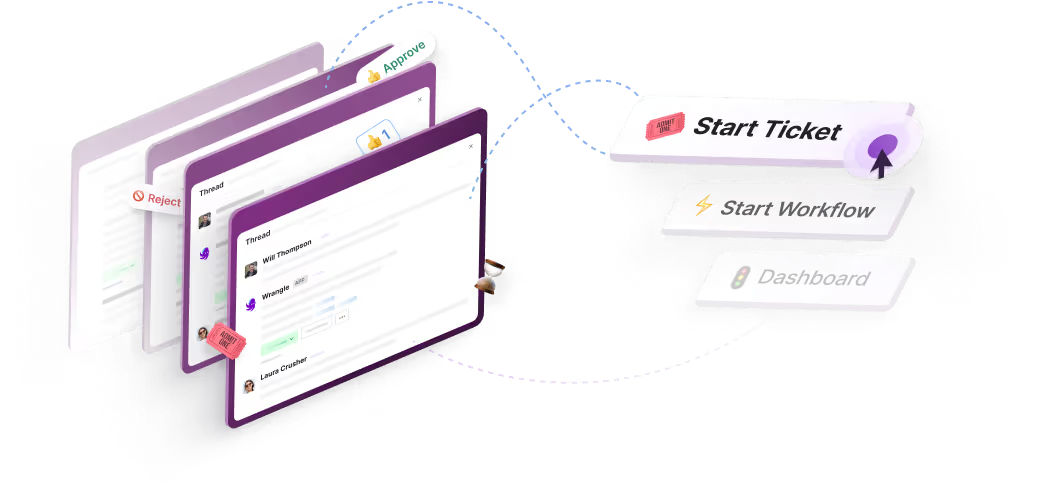A Complete Guide to Employee Offboarding
Learn how employee offboarding is key to your company's security and helps boost your reputation within your industry.


Everyone eventually leaves their job. When an employee exits, the employee offboarding process begins. Most companies have a basic offboarding system, but often the process isn’t thorough or efficient. In this post, we will talk about how to do offboarding right.
What Is Employee Offboarding?
Employee offboarding is part of the exit process, by which someone who is currently an employee transitions out of that role. The goal of an offboarding process is to ease the transition, both for the company and the employee. Remember: every employee who leaves under favorable circumstances is a potential future employee. Even if they never come back to work for you, they will talk to colleagues and professional contacts. How you manage their exit process influences what prospective employees will hear.
While our goal in this post is to cover a variety of offboarding procedures, it's important to remember that some will differ significantly. Some steps below won't work when you're unexpectedly firing someone. Trying to tackle knowledge transfer might not work well if the exiting employee is an intern who only worked for a week. You need to exercise sound judgment in your approach to every offboarding instance.
Offboarding an Employee
Let's dig into what makes an excellent offboarding experience. Every situation and company is unique. For example, if your business is focused on healthcare, employees might handle sensitive information. In this case, your offboarding process might be more vigorous than someone working in food services. Regardless of your industry, the steps below provide an outline for your company’s offboarding processes.
"If someone is leaving your company, everyone involved in the offboarding process must know about it."
Identify an Exit Event
If someone is leaving your company, everyone involved in the offboarding process must know about it. This is true whether the person is leaving voluntarily or without notice. You'll want a central location to track all the work your company undertakes to exit the employee. Many companies track this work on a third-party ticketing system, but even Google Forms can be used for checking off each item on the list. You may even find that something as simple as a Slack checklist will cover all the bases.
The key here is a well-defined list of steps with clear owners for each step. By defining the entire list up front and listing an owner for each step of the process, you increase the likelihood that your team successfully completes each step. When possible, identify a due date for each item on the checklist. For normal exits with advance notice, there are some steps you'll want to take right away and some you'll want to take on the employee's last day.
It may also help to have different checklists defined for different types of exits. The key goal here is to ensure that the responsible person completes each step of the offboarding checklist for every employee exit.
Knowledge Transfer
Many companies handle knowledge transfer poorly, and it becomes a hasty last-minute attempt to get an exiting employee to write down "all the important stuff" about their job. In reality, knowledge transfer is an institutional skill. If your team practices knowledge transfers on a regular basis, it's likely that this step will be perfunctory. It's also likely that you'll be well-equipped to take it on as part of an exit. Regular effective knowledge transfer also helps build stronger teams and gives your employees the context they need to do their job well.
Technical Offboarding
Technical offboarding is what many people think of first as an example of offboarding. In reality, it's only part of the process but a very important part. Technical offboarding means disabling or removing your employee's digital access across your company's footprint. This likely involves disabling access to email accounts and de-provisioning accounts to third-party software. For many companies, it also means revoking physical access to buildings.
Doing technical offboarding right is a big deal, no matter the size of your company. For some companies, it's a big deal because they handle sensitive personal information or customer health data. Quickly and easily disabling all of an employee's accounts is critical in the event that you're firing them. You don't want them to hear the news and extract valuable data or vandalize critical systems. But it can also have positive indirect effects on your company, too. For instance, many software licenses require you to pay by seat. So, when you correctly offboard an employee, you save the company money. The last thing you want is to pay for a license that isn't being used anymore.
How Can I Do Technical Offboarding Right?
Think of your offboarding process as a mirror of your onboarding process. Ideally, when you hire someone new, you have an automated system that either provisions user accounts automatically or assigns administrators to do so by hand. When that's the case, designing an offboarding process is simply asking that same system or user to do the opposite for the user in question. While it might take a little more time to set up an automated system to handle onboarding and offboarding, it's worth the extra effort. And Wrangle can help you automate this process in your Slack workspace.
Exit Interview
Not every company performs an exit interview. For some exits, it's simply not appropriate. Someone you are laying off or firing is unlikely to provide helpful feedback. But when the time is right, the exit interview is a powerful tool for ongoing company improvement. Take the time to ask thoughtful questions and really listen to people who are leaving, and you'll find that they regularly share valuable insights.
Reflect and Improve
When your employees share wisdom in exit interviews, it's helpful to share that feedback with people who are staying. But you shouldn't only share feedback with the employee's former team. This is a time for your team to reflect on how well you handled the offboarding process. It may not be necessary to undertake this process for every offboarding you do, especially if you work for a larger company where employee exits happen regularly. But you should set aside some time to reflect on the quality of your process and regularly seek ways to improve it.
"Automation tools are a secret superpower when defining an employee offboarding process."
Wrangle Can Help Automate Employee Offboarding
Automation tools are a secret superpower when defining an employee offboarding process. As we've discussed, it's critical to make sure that you cover every part of the offboarding process every single time. Onboarding is an employee's first impression of your company, but offboarding might be the last. Making their offboarding process easy helps ensure that they speak highly of you in the future.
An automated offboarding process is the safest way to ensure everything runs smoothly. And Wrangle is here to help automate all your business processes, including onboarding and offboarding.
Let’s look at how you could use Wrangle to automate the steps we’ve discussed. We talked about several essential parts of the exit process. Wrangle’s ticketing and workflow automation platform enables your team to manage employees offboarding with structure and ease systematically.
Let’s start by adding Wrangle to our workspace. Wrangle offers a free trial with no risk. You don’t even need a credit card.

Next, click Workflows to navigate to the no-code builder.

We can either use a template or create our own. Let’s select the blank template and start from scratch.

We will build a simple process to offboard team members when they exit. First, let’s create the intake form using the no-code web application. We will build it on the web, but the form is accessible in Slack for your workspace users. Our workflow includes the intake form process, an approval step, and several task lists. In our form, we will collect some basic information such as employee name, id number, type of exit event, and department. We’ll post the requests in our private people channel to ensure the employee's privacy and security of critical company data.

Once the intake form is submitted, the department manager must approve the request. Here, we’ve included an approval step for the manager Beverly.

We’ve created a conditional step that will only occur if the user is terminated. In these sensitive situations, we may need the IT team to take action swiftly. Therefore, if the manager selects “termination” in the intake form, our IT team will get a notification upon approval to deactivate the employee’s access to sensitive information. Once approved, the workflow will automatically move onto the “immediate technical offboarding.” If the conditional criteria aren’t met, our workflow will skip this step and move on to Technical Offboarding.

The technical offboarding step helps our IT team recall which systems should be deactivated. Most organizations will have a much longer list, but you can customize this list for your needs.

We’ve created a list of other tasks related to offboarding, which will be completed once the technical offboarding step is approved. We’ve added reminders for sending COBRA documentation, setting up an exit interview, retrieving hardware, etc. You could create whatever tasks your organization requires.

Once we click activate, our new workflow is automatically available in our Slack workspace. If you only want a certain level of employee to access a sensitive workflow, you can adapt the permissions on your account.

Your user agents can respond to requests in Slack or from within the Wrangle UI. The Wrangle web UI gives them a birds-eye view of everything happening in their Wrangle workflows inside your Slack workspace along with detailed reporting metrics.
Start automating your employee offboarding
Getting started is free. Relying on manual processes is error-prone, but Wrangle helps ensure that every onboarding and offboarding process is error-free.
This post was written by Eric Boersma. Eric is a software developer and development manager who's done everything from IT security in pharmaceuticals to writing intelligence software for the US government to build international development teams for non-profits. He loves to talk about the things he's learned along the way, and he enjoys listening to and learning from others as well.

- Try Wrangle free for 14 days
- Turn messages into trackable tickets
- Build a scalable help desk



Turn Slack into a productivity powerhouse with Wrangle
Create a scalable helpdesk in Slack. Automatically turn messages into trackable tickets and provide faster, more transparent service to your colleagues and customers with Wrangle — Try it free!






